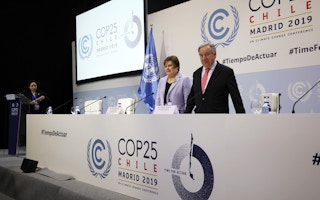“Who said it is impossible?”
The slogan of October’s COP25 preparatory meeting in Costa Rica was designed to spur global climate action. It was followed, oddly enough, by a series of improbable events.
Protests broke out in Santiago, Chile, trigged by a hike in subway ticket prices. As the demonstrations grew more intense the country’s president announced it could no longer host the COP. Spain stepped in to offer its capital as a substitute venue, the side events would take place as planned, and the “Blue COP” ocean focus would be retained. (Swedish activist Greta Thunberg, originally heading to Chile overland through the Americas, managed to hitch a lift on a boat and is set to arrive in time to attend most of the conference.)
The core agenda of COP25 has not been much affected by the venue change, but Chile’s leadership role may have been slightly weakened. Three key questions COP25 will try to answer are: Will China and other major nations boost their climate ambitions before 2020? Can the rules of international carbon markets be agreed upon? Will rich nations provide developing ones with the financial and technological support they need?
A weakened chair
There had been high hopes for the Santiago conference. Chile’s climate action and ambition far outstrip previous host, Poland. In recent years the country has promoted renewable energy development, with the International Energy Agency describing it as “a world-class destination for solar and wind energy developers.” In June, Chile announced it would be coal free by 2040, and carbon neutral by 2050. Amid a gloomy outlook for climate governance in recent years, Chile offered a ray of hope. The concern is that although still chairing the meeting in Madrid, the pressure of domestic affairs may leave Chile’s leaders with little time for climate diplomacy.
This year’s Amazon fires heightened international attention on deforestation and environmental damage in Latin America, and many NGOs from the region had hoped to use the Chile conference to raise awareness of environmental and social issues. The change of location has made it much harder for them to attend.
An unchanged agenda
COP25 will mainly discuss matters outstanding from last year’s negotiations. Though implementation guidelines for the Paris Agreement were agreed in Poland, consensus on several points was not reached.
Market mechanisms were a notable source of contention; particularly, how international carbon markets would work. This matter is sometimes referred to as Article 6, after the relevant part of the Paris Agreement. There is a need to avoid double-counting carbon credits traded between nations.
Developing nations did not used to need emissions reduction targets. Under Paris, all nations do. So to avoid double-counting, and thus overstating global progress on reducing emissions, carbon credits bought by developed nations need to be removed from the carbon accounts of developing ones.
Disagreements over this remain. Brazil has numerous carbon sequestration targets and hopes to allow some degree of double-counting. The EU and some others strongly oppose that. Qi Yue, a former member of China’s COP negotiating team, said China helped ease the way to last year’s compromise. That meant setting aside market mechanisms in order to ensure the implementation rulebook could be agreed on. China will likely continue to act as a mediator in this year’s talks, promoting the effective use of multilateral mechanisms, she added.
Another detail to be decided on is a common timeframe for climate targets. Most signatories to the Paris Agreement turned in ten-year action plans (2020-30), but some are working towards five-year plans (2020-25). This difference makes it harder to evaluate global progress. Post-2030 climate commitments need to be made under a common timeframe, but there are different preferences here: China and the EU would like five years; Japan, the US and Saudi Arabia want ten.
Hopefully, some crucial issues that are on the table at every COP will see strides made this year. These include how to ensure developed nations, including island states threatened by sea-level rise, provide developing ones with adequate financing and technological support.
‘Ambition, ambition, ambition’
This year’s agenda is relatively light, with the main purpose being to lay the foundations for next year’s COP in the UK. That’s when updated national climate targets – known as “nationally determined contributions” (NDCs) – are due, along with low-emission strategies for the period up to 2050.
A range of research has shown that the NDCs submitted so far come nowhere near meeting the Paris requirements. The UN’s Emissions Gap report recently demonstrated that without stronger action, the world will be 3.2C warmer by the end of the century.
At the close of last year’s talks, the UN secretary general, Antonio Guterres, said the key to future efforts is “ambition, ambition and ambition”. In September this year, he personally hosted a climate summit in New York, to which he asked attendees to “bring concrete plans, not beautiful speeches”. The New York talks saw some success, with 65 countries saying they would answer the call to boost action on climate change, but that willingness has yet to become action. Guterres will continue his efforts in Madrid.
In a November statement jointly issued with France, China said it will be handing in its 2050 low-emission development strategy in 2020, but remained vague on an update to its NDCs and timetable. The Innovative Green Development Program, a Chinese think-tank, has found China to have already achieved a number of its 2015 NDC goals. Many domestic scholars are optimistic that China will reach peak carbon before 2030. This all means there is scope for China to raise its sights.
The 2020 UN climate change conference will take place in Glasgow, UK. Despite this year’s talks falling in the middle of a UK general election, the government will send a senior representative to Madrid to present plans for next year. There are many uncertainties about the route to COP26, but as this year has shown, nothing is impossible.
This story originally published by Chinadialogue under a Creative Commons’ License.










